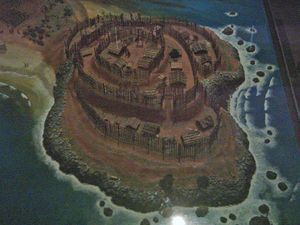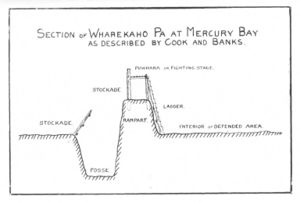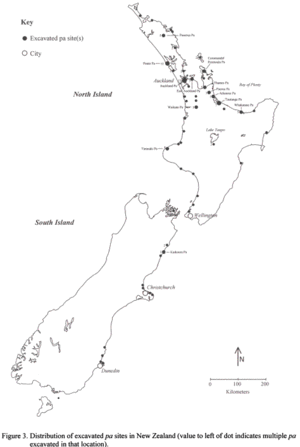Difference between revisions of "Pa"
m (→References) |
m (→Pa Classification and Defense) |
||
| Line 10: | Line 10: | ||
Pa were classified into three classes by Les Groube in 1969 according to the level of fortification applied to the site. While some sites were simply terraced beyond the palisade, others utilized ditches, banks, trench moats, and even a puwhara, or ‘fighting stage,’ built along the back of the palisade. The classes of palisade, according to Les Groube, were as follows; | Pa were classified into three classes by Les Groube in 1969 according to the level of fortification applied to the site. While some sites were simply terraced beyond the palisade, others utilized ditches, banks, trench moats, and even a puwhara, or ‘fighting stage,’ built along the back of the palisade. The classes of palisade, according to Les Groube, were as follows; | ||
| − | Class I – Terraces only. | + | * Class I – Terraces only. |
| − | Class II – Sites with banks and transverse ditches. | + | * Class II – Sites with banks and transverse ditches. |
| − | Class III – Sites with both transverse and lateral ditches and banks, as well as moated sites. | + | * Class III – Sites with both transverse and lateral ditches and banks, as well as moated sites. |
| − | Class IV - Palisades only. | + | * Class IV - Palisades only. |
| − | As of 1996, a total of 115 pa had been excavated: 22 class I, 38 class II, 26 class III, 14 class IV, and 5 of unknown class. Of these 115, 99 are on the | + | |
| + | As of 1996, a total of 115 pa had been excavated: 22 class I, 38 class II, 26 class III, 14 class IV, and 5 of unknown class. Of these 115, 99 are on the North Island. | ||
| + | |||
| + | {{Stub}} | ||
These fortifications could be erected quickly, and proved highly effective against even the most advanced foes, most notably the British Empire, who had limited success against the earthen fortifications of the Pa, which could in some way be considered the birthplace of trench warfare, as even firearms were unable to penetrate the packed defenses. | These fortifications could be erected quickly, and proved highly effective against even the most advanced foes, most notably the British Empire, who had limited success against the earthen fortifications of the Pa, which could in some way be considered the birthplace of trench warfare, as even firearms were unable to penetrate the packed defenses. | ||
[[Image:Image16.gif|thumb|right|Location of pa in New Zealand]] | [[Image:Image16.gif|thumb|right|Location of pa in New Zealand]] | ||
| − | |||
| − | |||
== Fort Interior == | == Fort Interior == | ||
Revision as of 23:28, 4 October 2010
A pa [pronounced: pah] is a Maori hill-fort dating from the 17th to 19th centuries. Built on hillsides or promontories, these fortifications were defined by their use of palisades, earthen banks, and ditches, and were most often built on coastal headlands. Cook, the first westerner to view a Pa, remarked that “the best engineer in Europe could not have chose a better [site] for a small number of men to defend themselves against a greater.” [2 36] While some pa were towns lived in year round, other smaller pa, despite their defensible position, were often left unattended in order for the residents to farm food in the surrounding areas.
Pa Classification and Defense
Pa were classified into three classes by Les Groube in 1969 according to the level of fortification applied to the site. While some sites were simply terraced beyond the palisade, others utilized ditches, banks, trench moats, and even a puwhara, or ‘fighting stage,’ built along the back of the palisade. The classes of palisade, according to Les Groube, were as follows;
- Class I – Terraces only.
- Class II – Sites with banks and transverse ditches.
- Class III – Sites with both transverse and lateral ditches and banks, as well as moated sites.
- Class IV - Palisades only.
As of 1996, a total of 115 pa had been excavated: 22 class I, 38 class II, 26 class III, 14 class IV, and 5 of unknown class. Of these 115, 99 are on the North Island.

|
This page is a Stub |
| Further content needs to be added. For changes please drop a note to the webmaster. |
These fortifications could be erected quickly, and proved highly effective against even the most advanced foes, most notably the British Empire, who had limited success against the earthen fortifications of the Pa, which could in some way be considered the birthplace of trench warfare, as even firearms were unable to penetrate the packed defenses.
Fort Interior
Withing the fortifications of the pa, there was generally some sort of dwelling area (with the exception of some built for the sole purpose of quick defense). Included would be houses of varying style and size, but consisting largely of rectangular architecture with pitched, wide-eaved, roofs. Outside of these houses were outdoor cooking areas, with some pa having outdoor sheds/awnings in which meals were taken. In addition to the dwellings, found within the sites of these forts are numerous storage areas. These areas took up a large part of the interior space, and in order to prevent animals from from getting to supplies were built as raised lofts. In some instances, the storage area would take the form of a large pit with raised edges.
Some Notable Sites
Rangihoua pa, Bay of Islands
Tiromoana pa, Te Awanga, Hawke's Bay
Manuaitu pa, Apetea, Waikato
Taniwha pa, Te Kauwhata
Paroa pa, Bay of Islands
References
Fox, Aileen. Prehistoric Maori Fortifications. New Zealand, Longman Paul Limited, 1976
Best, Elsdon. The Pa Maori. New Zealand, A. R. Shearer Government Printer, 1927
Best, Elsdon. The Maori - Volume II. New Zealand, Polynesian Society, 1941. (New Zealand Electronic Text Centre http://www.nzetc.org/etexts/Bes02Maor/Bes02Maor308a.jpg)
Schmidt, Matthew. Pa Excavation in New Zealand Archaeology: A History and Review. http://www.nzarchaeology.org/, 1996



